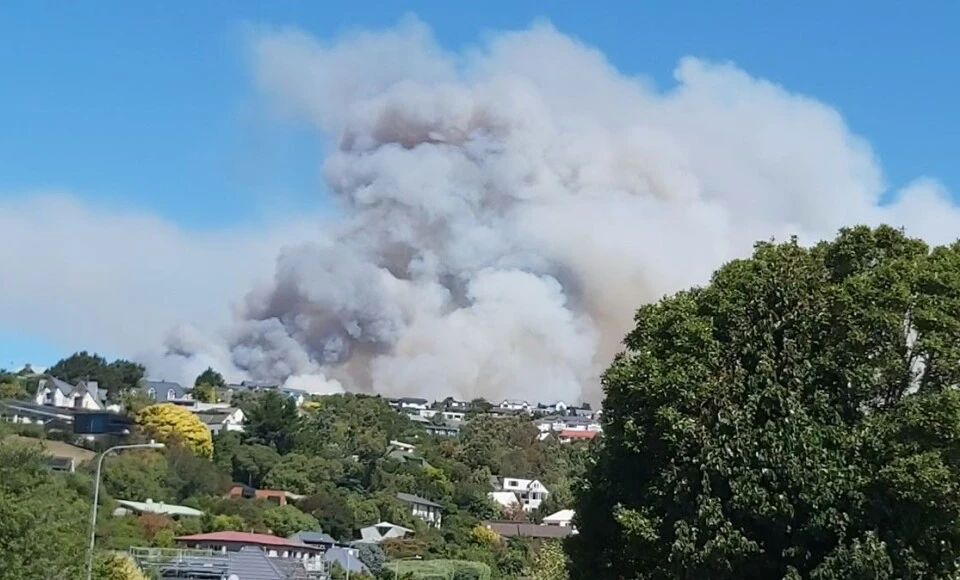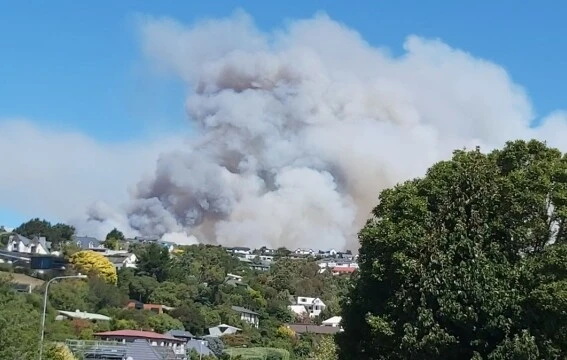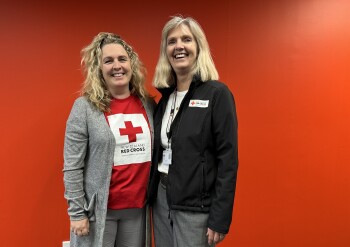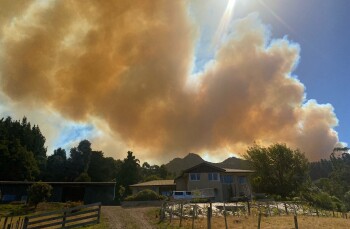Red Cross workers evacuated during the Port Hills fire benefit from Good and Ready preparedness
13 March 2024


Two New Zealand Red Cross staff members evacuated last month due to fire danger – exactly seven years since a large blaze swept through the Port Hills, claiming one person’s life. Good risk assessment was crucial to their decisions.
The Port Hills are about a 20-minute drive from the centre of Christchurch. Marketing Manager, Rowan Worner and her family live near Governors Bay, in a valley with around 12 houses. Just before 3pm on 14 March, she was driving back from work in Christchurch to pick up her three children from school. Clouds of smoke were coming from the Port Hills, and as she drove over the hill, the clouds got larger. She recalls, “although I didn’t fully take in the gravity of the situation at first, I had a feeling it wasn’t good”. A strong nor-wester wind was blowing and the hills were tinder dry from lack of rain.
Assessing risk
As Rowan drove to the school, she took note of the situation. “Friends live further down the valley but only a few of us drive to and from town daily, so others wouldn’t know the extent of the fire. I needed to gain information for ourselves, and to pass on to others.” Rowan also called her husband, Aaron, who had a prime view of where the fire was coming from.

Rowan Worner (left) and Sarah Gribbin
Rowan said she felt calm as she picked up her children, and didn’t think the fire would affect her house, but when they got home, things were very different. “The whole sky was red. The wind had changed direction and I knew there was real danger. The smoke had now reached the top of the hill and was funneling down our wee valley. I knew that meant the fire could also follow and we live half-way down.”
On the other side of the Port Hills, Psychological First Aid Advisor, Sarah Gribbin was working from home and in a Teams meeting when she heard sirens in her street, at 2.30pm. “I left my meeting and from outside my house I saw smoke billowing above the hill.”
Sarah also noticed firefighting helicopters landing and refueling just 150 metres from her home. She noted the wind was blowing away from her suburb, but Sarah says, “while I live at the bottom of the Port Hills, I knew a wind change could mean the fire could come down and around the bottom of the valleys towards my suburb". She also knew there were roadworks on the only route out, and that meant if people had to leave the area, the traffic would be a nightmare.
The evacuation
Back in Governors Bay, with Aaron arriving soon after Rowan, all the family were at home. They’d received two Emergency Mobile Alerts on their phones to evacuate. They had already decided to leave, packing up what they needed in just one and half hours. As they headed out the door, the police arrived to tell them to evacuate. They drove to a friend’s house in Christchurch, avoiding going over the hill where the fire was looming. “My friend is a real buddy. We’ve always been each other’s person – through COVID-19 and other difficult situations.”
Rowan remembers most of that night was spent listening to news updates and on the phone to friends in their valley – not knowing how the situation would evolve. “It was all quite stressful; I remember Aaron was reading our house insurance policy at 12.30am!”
Almost at the same time as Rowan, and after assessing the risks, Sarah also made the decision to leave in daylight. “My situation was not as extreme as Rowan’s but there was still risk.” She too received an alert to evacuate. Her own training helped her with the psychological impacts of this emergency. “You automatically go into flight, fight or freeze mode. Understanding which one you go into in these situations helps you prepare and counter the reactions. I go into flight mode, so learning how to stop and breathe has been essential to ensure I think clearly about what to do.” Sarah packed her essential documents, and with her emergency grab bag in her car, she headed to her son’s place in daylight. The trip that usually takes 30 minutes, took over an hour. “My decision to leave was something I could control – if I’d stayed, I’d have been up all night, worrying.”
Returning home and reflecting
Both Rowan and her family and Sarah returned to their unscathed homes the following night – with enormous relief.
For Rowan, the next few days were difficult due to the lingering smoke and being advised to stay indoors. Fortunately, the school opened the next day, so a sense of normality returned for the children. They all knew there was potential for the fire to reignite and Sarah kept her grab bag in her car.

Port Hills fire from near Governors Bay
Looking back, both Sarah and Rowan realised they were more prepared for an emergency where they were stuck at home, rather than having to evacuate. Rowan says, “we come from a line of earthquake survivors. We have cans, water, cooking supplies, and our essential papers organised well, but we were less prepared for evacuation – what, and how many clothes to take, for example – which is different from a grab bag. We made average decisions. Another challenge was to keep my stress levels in check to keep the kids calm".
“Children will hear things differently to adults,” says Sarah. “My own granddaughter was terrified by fires, but my son took her down to where she could see the helicopters refueling and now she plays with her toy helicopter and is asking for a water bucket to attach.” Rowan says a big de-stressor was on the Friday night following the fire, when she went to the pub with her local friends and had a good debrief talking about the event and listening to everyone’s experiences.
They also both agreed Civil Defence Emergency Management and Fire and Emergency New Zealand did a great job keeping people informed on social media.
Rowan and Sarah are pleased they’d already completed the New Zealand Red Cross’ Good and Ready Essentials four-step process on preparedness. It helped them assess the fire risk, and ensured they had emergency supplies and important documents at the ready – as well as having a buddy to turn to. “Completing Good and Ready Essentials is a really smart move. The steps get you to assess risk and prepare for emergencies. You don’t know what’s going to happen at any one time, and if you have no plan, no person and no supplies, your decision-making is even harder in these stressful situations,” says Sarah.
Find out more
Good and Ready Essentials
Prepare for a disaster - get Good and Ready
We partner with and use content provided by the National Emergency Management Agency
Get Ready - National Emergency Management Agency
Lead photo: Port Hills fire, February 2024.
